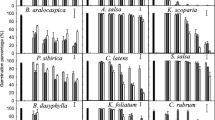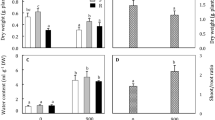Abstract
Though halophytes are naturally adapted to salinity, their salt-tolerance limits are greatly influenced by their provenance and developmental stage. In the present study, physio-biochemical responses of two Tunisian ecotypes of the oilseed coastal halophyte Cakile maritima (Brassicaceae) to salinity (0–400 mM NaCl) were monitored during germination and vegetative growth stages. Tabarka and Jerba seeds were collected from humid or arid climatic areas, respectively. Plant response to salinity appeared to depend on the ecotype and salinity levels. Increasing salinity inhibited germination process. Jerba seeds were found to be more salt tolerant than the Tabarka ones. At the autotrophic stage of growth and under salt-free conditions, Jerba was less productive than Tabarka (in terms of dry matter accumulation), but plant biomass production and leaf expansion (area and number) of the former ecotype were progressively improved by 100 mM NaCl, as compared to the control. In contrast, at the same salt concentration, these parameters decreased under increasing salinity in Tabarka (salt sensitive). Leaf chlorophyll content was reduced at severe salinity, but this effect was more conspicuous in the sensitive Tabarka plants. Na+ contents in the Jerba and Tabarka leaves collected from the 400 mM NaCl-treated plants were 17- and 12-fold higher than in the respective controls. This effect was accompanied by a significant reduction in the leaf K+, Mg2+ and Ca2+ contents, especially in the salt-treated Tabarka. A significant accumulation of proline and soluble carbohydrates in leaves was found during the period of intensive leaf growth. These organic compounds likely play a role in leaf osmotic adjustment and in protection of membrane stability at severe salinity.









Similar content being viewed by others
References
Ahmad I, Wainwright SJ, Stewart GR (1981) The solute and water relations of Agrostis stolonifera ecotypes differing in their salt tolerance. New Phytol 87:615–629
Ali G, Srivastava PS, Iqbal M (1999) Proline accumulation, protein pattern and photosynthesis in regenerants grown under NaCl stress. Biol Plant 42:89–95
Agastian P, Kingsley SJ, Vivekanandan M (2000) Effect of salinity on photosynthesis and biochemical characteristics in mulberry genotypes. Photosynthetica 38:287–290
Ashraf M (1993) Effect of sodium chloride on water relations and some organic osmotica in arid zone plant species Melilotus indica (L.) All Der Tropen 94:95–102
Ashraf M (1994) Organic substances responsible for salt tolerance in Eruca sativa. Biol Plant 36:61–71
Ashraf M, Harris PJC (2004) Potential biochemical indicator of salinity tolerance in plants. Plant Sci 166:3–16
Ashraf M, Tufail M (1995) Variation in salinity tolerance in sunflower (Helianthus annuus L.). J Agr Soil Sci 174:351–362
Ashraf M, Zafar ZU, O’Learly JW (1995) Genetic variation for salt tolerance in sunflower (Helianthus annuus L.). Hereditas 123:141–145
Bates LS, Waldren RP, Teare ID (1973) Rapid determination of free proline for water stress studies. Plant Soil 39:205–207
Cram WJ (1976) Negative feedback regulation of transport in cells. The maintenance of turgor, volume and nutrient supply. In: Luttge U, Pitman MG (ed.) Encyclopaedia of plant physiology, vol. 2, New Series. Springer, Berlin, pp 284–316
Davy AJ, Scott R, Cordazzo CV (2006) Biological flora of the British Isles: Cakile maritima Scop. J Ecol 94:695–711
De Souza Filho GA, Ferreira BS, Dias JM, Queiroz KS, Branco AT, Bressan-Smith RE, Oliveira JG, Garcia AB (2003) Accumulation of salt protein in rice plants as a response to environmental stresses. Plant Sci 164:623–628
Debez A, Chaïbi W, Bouzid S (2001) Effet de NaCl et de régulateurs de croissance sur la germination d’Atriplex halimus L. Cahiers Agric 10:135–138
Debez A, Ben Hamed K, Grignon C, Abdelly C (2004) Salinity effects on germination, growth, and seed production of the halophyte Cakile maritima. Plant Soil 262:179–189
Essa TA (2002) Effect of salinity stress on growth and nutrient. Composition of Three Soybean (Glycine max L. Merrill) Cultivars. J Agr Crop Sci 188:86–93
Flowers TJ, Hajibagheri MA, Clipson NJW (1986) Halophytes. Quart Rev Biol 61:313–337
Flowers TJ, Yeo AR (1995) Breeding for salinity resistance in crop plants: where next? Aust. J Plant Physiol 22:875–884
Fougere F, Rudulier D, Streeter JG (1991) Effects of salt stress on amino acid, organic acid, and carbohydrate composition of roots, bacteroids, and cytosol of alfalfa (Medicago sativa L.). Plant Physiol 96:1228–1236
Gadallah MAA (1999) Effects of proline and glycinebetaine on Vicia faba response to salt stress. Biol Plant 42:249–257
Glenn EP, Brown JJ, Blumwald E (1999) Salt tolerance and crop potential of halophytes. Crit Rev Plant Sci 18:227–255
Gunasekera CP, Martin LD, Siddique KHM, Walton GH (2006) Genotype by environment interactions of Indian mustard (Brassica juncea L.) and canola (B. napus L.) in Mediterranean-type environments. Crop growth and seed yield Europ J Agr 25:1–12
Hewitt EJ (1966) Sand and water culture methods used in the study of plant nutrition. Common wealth Bureau of Horticulture. Tech Com 22:431–446
Katembe WJ, Ungar IA, Mitchell JP (1998) Effect of salinity on germination and seedling growth of two Atriplex species (Chenopodiaceae). Ann Bot 82:167–175
Khan MA, Gul B, Weber D (2002) Seed germination in the great basin halophyte Salsola iberica. Can J Bot 80:650–655
Iyengar ERR, Reddy MP (1996) Photosynthesis in high salt-tolerant plants. In: Pesserkali M (ed) Hand book of photosynthesis. Marshal Dekar, Baten Rose, pp 56–65
Lieth H, Moschenko M, Lohmann M, Koyro HW, Hamdy A (1999) Halophyte uses in different climates. I. Ecological and ecophysiological studies. Backhuys Publishers, Leiden
Maggio A, Reddy MP, Joly RJ (2000) Gas exchange and solute accumulation in the halophyte Salvadora persica grown at moderate salinity. Env Exp Bot 44:31–38
Marschner H (1995) Mineral nutrition of higher plants. Academic, London
Mc Cready RM, Guggolz J, Silviera V, Owes HS (1950) Determination of starch and amylase in vegetables, application to peas. Annal Chem 22:1156–1158
Meloni DA, Gulotta MR, Martinez CA, Oliva MA (2004) The effect of salt stress on growth, nitrate reduction and proline and glycine betaine accumulation in Prosopis alba. Braz J Plant Physiol 16(1):39–46
Moghaieb REA, Saneoka H, Fujita K (2004) Effect of salinity on osmotic adjustment, glycine betaine accumulation and the betaine aldehyde dehydrogenase gene expression in two halophytic plants, Salicornia europaea and Suaeda maritima. Plant Sci 166:1345–1349
Murakeozy EP, Nagy Z, Duhaz C, Buchereau A, Tuba Z (2003) Seasonal changes in the levels of compatible osmolytes in three halophytic species of inland saline vegetation in Hungary. J Plant Physiol 160:395–401
Noe GB, Zedler JB (2000) Differential effects of four abiotic factors on the germination of salt marsh annuals. Am J Bot 87:1679–1682
O’Leary JW (1984) The role of halophytes in irrigated agriculture. In: Staples RC, Toenniessen GH (eds) Salinity tolerance in plants: strategies for crop improvement. Wiley, New York, pp 285–300
Petrusa LM, Winicov I (1997) Proline status in salt-tolerant and salt-sensitive alfalfa cell lines and plants in response to NaCl. Plant Physiol Biochem 35:303–310
Popp M, Smirnoff N (1995) Polyol accumulation and metabolism during water deficit. In: Smirnoff N (ed) Environment and plant metabolism: flexibility and acclimation. Bios Scientific, Oxford, pp 199–215
Slama I, Ghnaya T, Messedi D, Hessini K, Labidi N, Savoure A, Abdelly C (2007) Effect of sodium chloride on the response of the halophyte species Sesuvium portulacastrum grown in mannitol-induced water stress. J Plant Res (in press)
Staub AM (1963) Extraction, identification et dosages des glucides dans les extraits d’organes et les corps bactériens, In: Masson et Compagnie (eds) Techniques de laboratoire (Tome 1 et 2), Paris, pp 1307–1366
Tipirdamaz R, Gagneul D, Duhazé C, Aïnouche A, Monnier C, özkum D, Larher F (2005) Clustering of halophytes from an inland salt marsh in Turkey according to their ability to accumulate sodium and nitrogenous osmolytes. Env Exp Bot 57(1–2):139–153
Torrecillas A, Leon A, Del Amor F, Martinez-Monpean MC (1984) Determinacion rapida de clorofila en discos foliares de limonero. Fruits 39:617–622
Ungar IA (1996) Effect of salinity on seed germination, growth, and ion accumulation of Atriplex patula (Chenopodiaceae). Am J Bot 83:604–607
Acknowledgments
This work was supported by the Tunisian-French “Comité Mixte de Coopération Universitaire” (CMCU) network # 02FO924.
Author information
Authors and Affiliations
Corresponding author
Additional information
Communicated by A. Kacperska-Lewak.
Rights and permissions
About this article
Cite this article
Megdiche, W., Amor, N.B., Debez, A. et al. Salt tolerance of the annual halophyte Cakile maritima as affected by the provenance and the developmental stage. Acta Physiol Plant 29, 375–384 (2007). https://doi.org/10.1007/s11738-007-0047-0
Received:
Revised:
Accepted:
Published:
Issue Date:
DOI: https://doi.org/10.1007/s11738-007-0047-0




